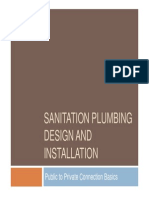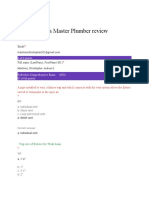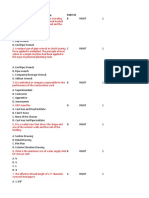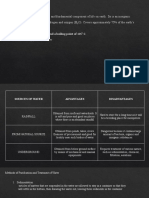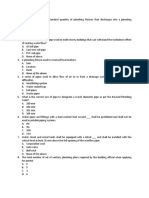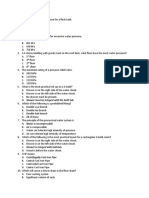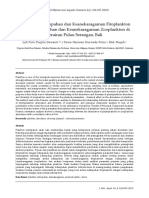0 ratings0% found this document useful (0 votes)
235 viewsLESSON 5 Wastewater Treatment and Disposal
Primary treatment involves removing grit, sedimentation, and primary clarification. Grit such as sand and glass is removed using grit chambers to prevent damage to equipment. In sedimentation, particles heavier than water are allowed to settle in tanks, forming sludge at the bottom. Primary clarifiers further separate solids from sewage after grit removal. Secondary treatment using microorganisms biologically breaks down organic pollutants, mostly through activated sludge and trickling filter processes. Microbes like bacteria and fungi metabolize organics in wastewater, converting them to carbon dioxide.
Uploaded by
fuchima07Copyright
© © All Rights Reserved
Available Formats
Download as PPTX, PDF, TXT or read online on Scribd
0 ratings0% found this document useful (0 votes)
235 viewsLESSON 5 Wastewater Treatment and Disposal
Primary treatment involves removing grit, sedimentation, and primary clarification. Grit such as sand and glass is removed using grit chambers to prevent damage to equipment. In sedimentation, particles heavier than water are allowed to settle in tanks, forming sludge at the bottom. Primary clarifiers further separate solids from sewage after grit removal. Secondary treatment using microorganisms biologically breaks down organic pollutants, mostly through activated sludge and trickling filter processes. Microbes like bacteria and fungi metabolize organics in wastewater, converting them to carbon dioxide.
Uploaded by
fuchima07Copyright
© © All Rights Reserved
Available Formats
Download as PPTX, PDF, TXT or read online on Scribd
You are on page 1/ 24
pegslides 2014
Wastewater Treatment and
Disposal
Lesson 5
Primary Treatment
pegslides 2014
Grit removal
The removal of gritty material
suspended in raw sewage such as sand,
coffee grounds, eggshells, etc.
Flow velocity should not be less than
the self-cleansing velocity (0.6 m/s)
pegslides 2014
Grit
Inert dense material such as sand,
broken glass, silt and pebbles
When not removed from wastewater,
they abrade pumps and devices
Settle in corners and bends reducing
flow capacity
pegslides 2014
Grit chambers
Long, narrow tanks wherein production
in velocity and collection of grit are
made
Rising air bubbles help to keep the
organic solids in suspension while grit
settles in the bottom
pegslides 2014
Water Treatment Process
1. Primary treatment
a. Screening
b. Comminuting
c. Grit removal
d. Sedimentation
2. Secondary treatment
a. Sloughing
b. Recirculation
pegslides 2014
Sedimentation
When flow velocities and turbulence
are minimal, particles that are
denser than water settle to the
bottom of the tank.
Sludge layer of accumulated solids
at the bottom of the tank
pegslides 2014
Primary clarifiers
Settling tanks that receive sewage
after grit removal
Coagulants
chemicals that allow very small suspended
particles to collide, stick together and
form settleable flocs
increase removal efficiency of primary
settling tanks
pegslides 2014
Secondary Treatment
pegslides 2014
Secondary Treatment
To achieve BOD and TSS removal
efficiencies of at least 85% as
required by the Clean Water Act, this
process must follow
Purpose: to remove the suspended
solids that did not settle out in the
primary tanks
pegslides 2014
Microorganisms
Biological treatment of sewage
involves the use of microbes to
consume the organic pollutants as
food.
Examples:
Bacteria
Fungi
Algae
Protozoa
Rotifers and Crustaceans
pegslides 2014
Why should we keep microbes happy?
Microbes metabolize the biodegradable
organics. Thus converting them into
CO
2
.
They stabilize the organic pollutants
in a controlled, artificial
environment (the tank)
pegslides 2014
Most Common Biological Treatments
1. Trickling Filter
2. Activated Sludge Process
pegslides 2014
Trickling Filters
Consists of a bed of crushed rock
(~2m deep)
Usually in circular with a diameter
as large as 60m
pegslides 2014
Trickling Filter Process
Primary effluent
is wastewater that flows out from a
treatment plant or individual treatment
process
is sprayed over the surface of the
crushed stone bed and trickles downward
to an underdrain system
pegslides 2014
Trickling Filter
Is not a filter at all, in the true
sense of the word.
The stones in a trickling filter only
serve to provide a large amount of
surface area for the biological
growth
pegslides 2014
Underdrain System
Serves to collect and carry away the
wastewater from the bottom of the bed
and to permit air circulation upward
through the stones
pegslides 2014
Sloughing
Pronounced as sluffing
When slime layer gets thicker and
gets washed off from surfaces of
stones by flowing water
pegslides 2014
Secondary Clarifier
Also known as final clarifier
A sedimentation tank where the
collected trickling filter effluent
in the underdrain system is conveyed
pegslides 2014
Recirculation
Can serve to improve the pollutant
removal efficiency
Direct Recirculation one common
pattern of recirculation
pegslides 2014
Activated Sludge
Is a suspended-growth system because
microbes are thoroughly mixed and
suspended in the wastewater flows
rather than attached to a particular
surface
pegslides 2014
pegslides 2014
pegslides 2014
pegslides 2014
You might also like
- 04 Sanitation Plumbing Design and Installation July 2024No ratings yet04 Sanitation Plumbing Design and Installation July 202462 pages
- D. Joining Fitting A. Adapter: A. Connect in Succession in Order To Avoid Vertical ObstructionNo ratings yetD. Joining Fitting A. Adapter: A. Connect in Succession in Order To Avoid Vertical Obstruction4 pages
- PLUMBING and SANITARY SYSTEMS TOPIC 4 LectureNo ratings yetPLUMBING and SANITARY SYSTEMS TOPIC 4 Lecture52 pages
- Topic 3 Plumbing Fixtures Module 19 - Soil FixturesNo ratings yetTopic 3 Plumbing Fixtures Module 19 - Soil Fixtures7 pages
- 08 - Set A - Plumbing & Sanitary Systems-1 PDFNo ratings yet08 - Set A - Plumbing & Sanitary Systems-1 PDF12 pages
- Plumbing - Reviewer - Docx - Filename UTF-8''plumbing Reviewer-1 PDFNo ratings yetPlumbing - Reviewer - Docx - Filename UTF-8''plumbing Reviewer-1 PDF1 page
- Sanitary Plumbing Design and InstallationNo ratings yetSanitary Plumbing Design and Installation6 pages
- Plumbing Review 09: Arch. A. M. Agusin, Uap100% (6)Plumbing Review 09: Arch. A. M. Agusin, Uap34 pages
- Module 6 - Domestic Hot Water Supply SystemsNo ratings yetModule 6 - Domestic Hot Water Supply Systems26 pages
- Splbe - Master Plumber (Psme-Sa, Uap, Pice) Quiz: MP Splbe Compiled By: O.T. AnoNo ratings yetSplbe - Master Plumber (Psme-Sa, Uap, Pice) Quiz: MP Splbe Compiled By: O.T. Ano3 pages
- Sanitation, Plumbing Design, and InstallationNo ratings yetSanitation, Plumbing Design, and Installation12 pages
- SPDI Coaching July 2024 MPLE by Engr. Jason Mejia100% (2)SPDI Coaching July 2024 MPLE by Engr. Jason Mejia84 pages
- Design of Sewage Treatment Plant With Uasb Technology0% (1)Design of Sewage Treatment Plant With Uasb Technology64 pages
- Performance Evaluation of Waste Water Treatment Plant: January 2010No ratings yetPerformance Evaluation of Waste Water Treatment Plant: January 201013 pages
- FINAL 9 Horti CROPS - GAP PROTOCOL AND GUIDELINENo ratings yetFINAL 9 Horti CROPS - GAP PROTOCOL AND GUIDELINE192 pages
- 2025_Silva_fal__Seasonal_and_extreme_water_level_fluctuations_impact_methane_concentrations_and_fluxes_in_two_Amazon_tributaries_near_Manaus_106351No ratings yet2025_Silva_fal__Seasonal_and_extreme_water_level_fluctuations_impact_methane_concentrations_and_fluxes_in_two_Amazon_tributaries_near_Manaus_1063511 page
- Unit 6: Human Communities and The EnvironmentNo ratings yetUnit 6: Human Communities and The Environment23 pages
- Get Water Supply Engineering Volume - 1 Dr. P.N. Modi PDF ebook with Full Chapters Now100% (6)Get Water Supply Engineering Volume - 1 Dr. P.N. Modi PDF ebook with Full Chapters Now37 pages
- Design and Construction of and Automatic Small Scale Water Treatment MachineNo ratings yetDesign and Construction of and Automatic Small Scale Water Treatment Machine34 pages
- Sharing Planet Earth - PPT-2 (2023-24) - Final TermNo ratings yetSharing Planet Earth - PPT-2 (2023-24) - Final Term12 pages
- Conservation and Wise Use of Vembanad-KolNo ratings yetConservation and Wise Use of Vembanad-Kol137 pages
- Hubungan Kelimpahan Dan Keanekaragaman Fitoplankton Dengan Kelimpahan Dan Keanekaragaman Zooplankton Di Perairan Pulau Serangan, BaliNo ratings yetHubungan Kelimpahan Dan Keanekaragaman Fitoplankton Dengan Kelimpahan Dan Keanekaragaman Zooplankton Di Perairan Pulau Serangan, Bali12 pages
- 2.1 Water - Its Components PPT - Pptx-CompressedNo ratings yet2.1 Water - Its Components PPT - Pptx-Compressed75 pages








